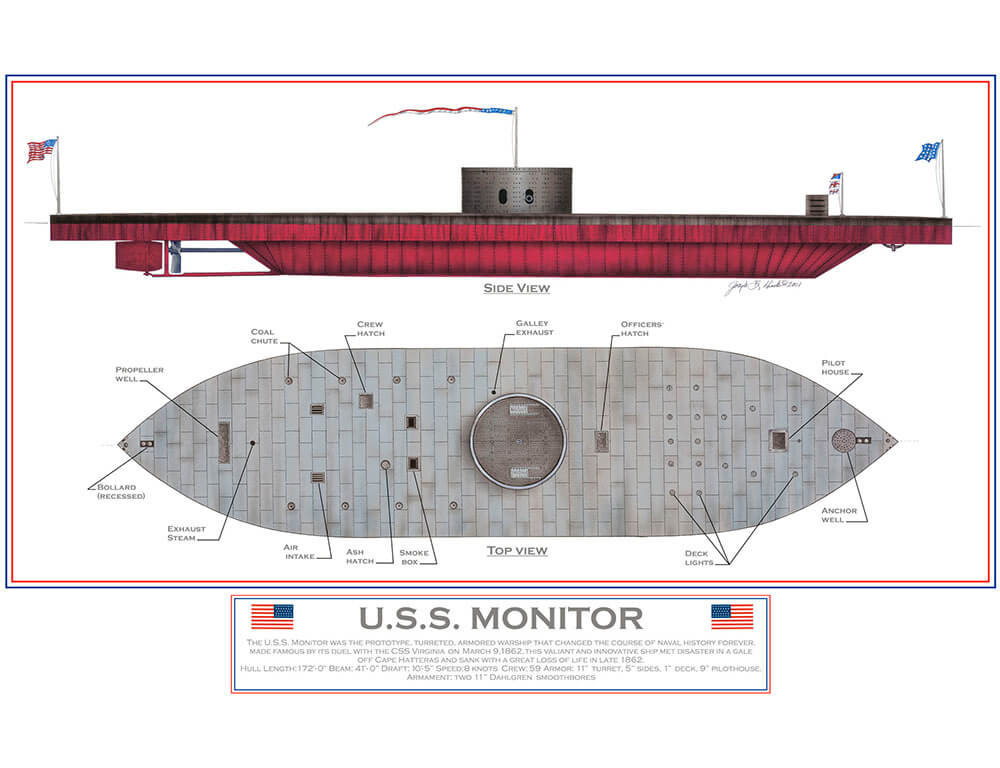Studying the USS Monitor

Since the establishment of Monitor National Marine Sanctuary in 1975, Monitor's historic significance has captured the attention of researchers and archaeologists. Over the years, numerous research and recovery expeditions have been organized by NOAA and partners.
During the first submersible dive to the Monitor wreck site in 1977, an archaeologist spotted a brass navigation lantern near the turret. This lantern was of particular interest because of its red Fresnel lens, evidence that it was a signal lantern. Paymaster William Keeler mentioned in his account of watching Monitor sink on New Year's Eve in 1862, that at approximately 1:30 am, the red distress lantern burning atop the turret and the ship itself were no longer visible. This lantern was the last visible sign of Monitor before it sank and the very first artifact recovered from the wreck. The lantern is currently on display in the USS Monitor Center at The Mariners' Museum and Park in Newport News, Virginia.
Since 1977, efforts to document the Monitor wreck site also included the recovery of artifacts and even human remains of two Monitor sailors. During two early expeditions, NOAA recovered numerous small artifacts in 1979 and the four-fluked anchor in 1983.
In 1987, after NOAA completed a baseline study, scientists noted an alarming pattern of accelerated deterioration in several areas of the wreck. Due to this alarming rate of decay, Congress gave NOAA a mandate in 1996 to develop a plan to preserve Monitor. NOAA released its long-range plan in 1998, and it outlined a six-step proposal for stabilizing Monitor's hull and recovering the vessel's steam engine and rotating gun turret.
With the help of the U.S. Navy in 1998, NOAA recovered Monitor's nine-foot cast iron propeller and 11 feet of shaft. In 2000, NOAA and partners stabilized the wreck, and in 2001 brought up more than 250 artifacts, including the vibrating lever steam engine. After a 41-day recovery effort in 2002, NOAA and the U.S. Navy raised Monitor's gun turret with two 11-inch Dahlgren cannons. Since 2002, no other artifacts have been recovered.
Although unpredictable weather and harsh conditions – as well as the vessel's depth and distance from shore – can often be deterrents to research, there is still much to be learned about Monitor and the surrounding area. The wreck continues to be mapped, documented, and studied with an expedition in 2006 and survey work completed in 2009, 2010, 2011, 2015, 2017, 2018, and 2022. These expeditions and survey work create new photomosaics, images, and 3D models of USS Monitor. Each trip to Monitor reveals new information that gives a deeper understanding of Monitor's legacy.
Shipwreck Biology
Monitor National Marine Sanctuary is located on the slope of the continental shelf in the warm Gulf Stream waters, making it suitable for a variety of marine life. The types of habitats observed within the sanctuary's boundaries include scattered natural rocky outcrops, sand flats, muddy patches, and artificial hard surfaces created by Monitor itself and a few scattered artifacts.
The sanctuary was established primarily because of its cultural resources, and for over 50 years the vast majority of research at the site has focused on the shipwreck and its history. But scientists today find that the sanctuary has high densities of benthic infauna and organic carbon, and a significant concentration of benthic fish and megafaunal invertebrates.
To learn more about the conditions and trends found at Monitor National Marine Sanctuary, read the 2008 condition report.

